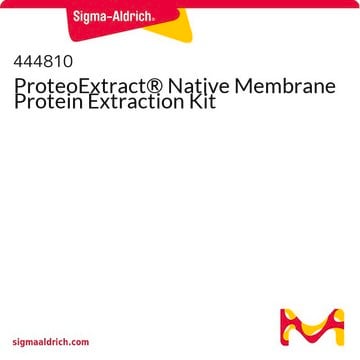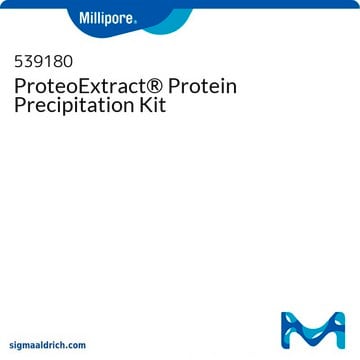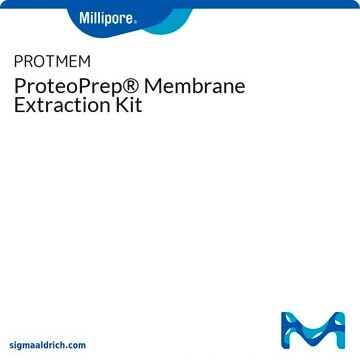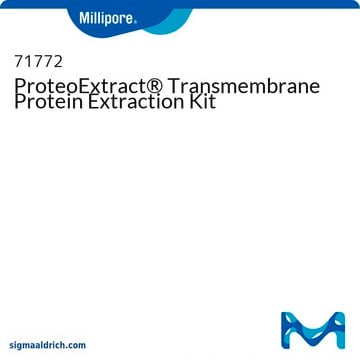539790
ProteoExtract® Subcellular Proteome Extraction Kit
Synonyme(s) :
S-PEK Kit
About This Item
Produits recommandés
Utilisation
sufficient for 20 extractions
Fabricant/nom de marque
Calbiochem®
Conditions de stockage
OK to freeze
avoid repeated freeze/thaw cycles
Technique(s)
fractionation: suitable
Entrée
sample type: mammalian tissue(s)
sample type: mammalian cultured cells
Conditions d'expédition
ambient
Température de stockage
2-8°C
Description générale
ProteoExtract® Subcellular Proteome Extraction Kit (S-PEK) is designed for fast and reproducible extraction of subcellular proteomes from adherent and suspension-grown mammalian cells. The S-PEK takes advantage of the different solubilities of certain subcellular compartments in the four selected reagents. In the case of adherent cells, the procedure is performed directly in the tissue culture dish without the need for cell removal. Cells or the parts of the cells remain attached to the plate during sequential extraction of subcellular compartments, until the appropriate extraction reagent is used. Thus, the early destruction of the cellular structure by enzymatic or mechanical detachment of cells from the tissue culture plate and any mixing of different subcellular compartments is prevented. For suspension-grown cells, extraction starts with gentle sedimentation and washing of the cells. The stepwise extraction delivers four distinct protein fractions from one sample:
- Cytosolic fraction (F1)
- Membrane/organelle protein fraction (F2)
- Nucleic protein fraction (F3)
- Cytoskeletal fraction (F4)
Sample size: 3-5x106 or 25-50 mg tissue.
Caractéristiques et avantages
- Stepwise extraction resulting in four distinct subcellular proteomes from one sample
- Highly reproducible
- No ultracentrifugation steps
- Fast—needs just 2 hours with 45 minutes hands-on time
- Produces proteins suitable for functional studies
Composants
Avertissement
Principe
Notes préparatoires
The volume of each component required for one subcellular extraction depends on the amount of starting material.
- Adherent tissue culture cells
- Suspension-grown tissue culture cells
- Frozen cell pellets
- Fragmented tissue
Stockage et stabilité
Autres remarques
Yuan, X., et al. 2002. Electrophoresis23, 1185.
Butcher, et al. 2001. J. Immunol.167, 2193.
Ott, et al. 2001. Pharmacogenomics J.1, 142.
Allen, L. 2000. Nature405, 819.
Dunn, M. J. 2000. Electrophoresis 6.
Rabilloud, T. 2000. Two-dimensional Gel Electrophoresis and Identification Methods Springer-Verlag
Mejdoubi, et al. 1999. Biochem. Biophys. Res. Comm.254, 93.
Reymond, et al. 1997. Electrophoresis18, 2842.
Laemmli, U. K. 1970. Nature227, 680.
Lowry, et al. 1951. J. Biol. Chem.193, 265.
http://www.expasy.ch/ and http://www.expasy.proteome.org.au
Informations légales
Classification des risques
Aquatic Chronic 3 - Eye Irrit. 2 - Skin Irrit. 2
Classe de danger pour l'eau (WGK)
WGK 3
Certificats d'analyse (COA)
Recherchez un Certificats d'analyse (COA) en saisissant le numéro de lot du produit. Les numéros de lot figurent sur l'étiquette du produit après les mots "Lot" ou "Batch".
Déjà en possession de ce produit ?
Retrouvez la documentation relative aux produits que vous avez récemment achetés dans la Bibliothèque de documents.
Les clients ont également consulté
Notre équipe de scientifiques dispose d'une expérience dans tous les secteurs de la recherche, notamment en sciences de la vie, science des matériaux, synthèse chimique, chromatographie, analyse et dans de nombreux autres domaines..
Contacter notre Service technique













